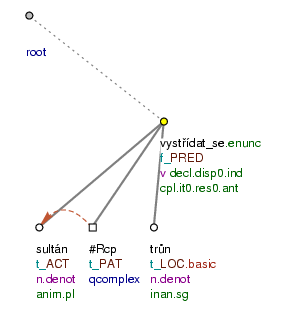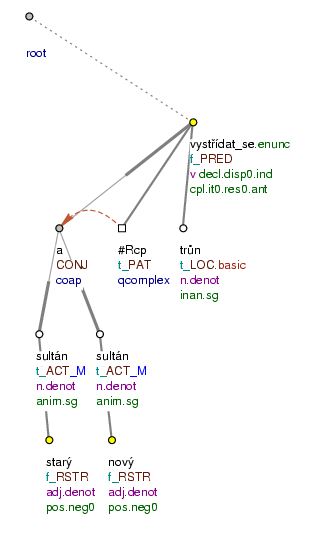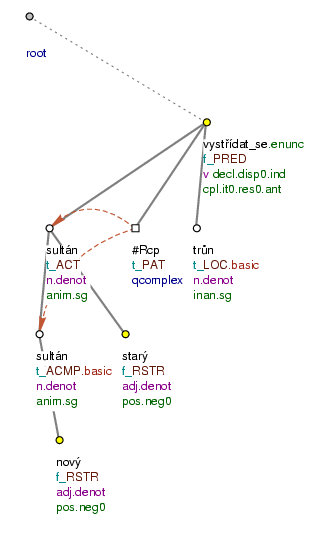Grammatical coreference is also involved in constructions involving reciprocity (see Section 2.4.2, "Reciprocity"). If a new node with the #Rcp t-lemma is inserted into the structure as a consequence of it being non-expressed (which is a result of reciprocity), there is always a grammatical coreference relationship indicated in the tree, going from the node with the #Rcp t-lemma to the node it is in the reciprocal relation with. Three basic situations can be found:
-
there is a grammatical coreference relation between the node with the
#Rcpt-lemma and a single node for a full lexical item. This is the case when two elements in the reciprocal relation are expressed by a noun in plural or a noun that is semantically plural. Cf.:-
Sultáni se vystřídali {
#Rcp.PAT} na trůnu. (=lit. Sultans REFL changed on throne)As there is reciprocity involved in the construction, the non-expressed Patient of the verb vystřídat (=change) corefers with the Actor of the verb, which is expressed by a plural noun form of sultán. There is a grammatical coreference relation going from the newly established node with the
#Rcpt-lemma to the node for the noun sultáni (=sultans). Cf. Fig. 9.86.
-
-
there is a grammatical coreference relation between the newly established node with the
#Rcpt-lemma and a paratactic structure root node. This happens if two coordinated modifications are in a reciprocal relation. Cf.:-
Starý sultán a nový sultán se vystřídali {
#Rcp.PAT} na trůnu. (=lit. Old sultan and new sultan REFL changed on throne)As a result of reciprocity, the missing Patient of the verb vystřídat (=change) corefers with the Actor of the verb, which is expressed by the coordination (starý) sultán a (nový) sultán. There is a grammatical coreference relation going from the newly established node with the
#Rcpt-lemma to the paratactic structure root node, the conjunction a (=and). Cf. Fig. 9.87.
-
-
there is a grammatical coreference relation between the newly established node with the
#Rcpt-lemma and two nodes for full lexical items. This happens if two elements are in the reciprocal relation which are in a kind of hypotactic coordination, i.e. connected by the preposition s+7. Cf.:-
Starý sultán s novým sultánem se vystřídali {
#Rcp.PAT} na trůnu. (=lit. Old sultan with new sultan REFL changed on throne)As there is reciprocity involved in the construction, the non-expressed Patient of the verb vystřídat (=change) corefers with the Actor of the verb, which is expressed by two nouns, connected by a preposition, namely starý sultán s novým sultánem (=lit. old sultan with new sultan). The grammatical coreference relation is going from the newly established node with the
#Rcpt-lemma to the node for (starý) sultán as well as to the node for (nový) sultán. Cf. Fig. 9.88.
-
Coreference in constructions in which there is reciprocity between modifications of nouns is represented in a similar way.
For a detailed discussion of reciprocity and more examples, see Section 2.4.2, "Reciprocity".
Figure 9.86. Coreference in constructions with reciprocity

Sultáni se vystřídali na trůnu. (=lit. Sultans REFL changed on throne)

